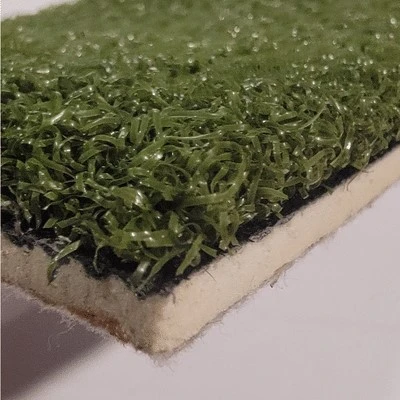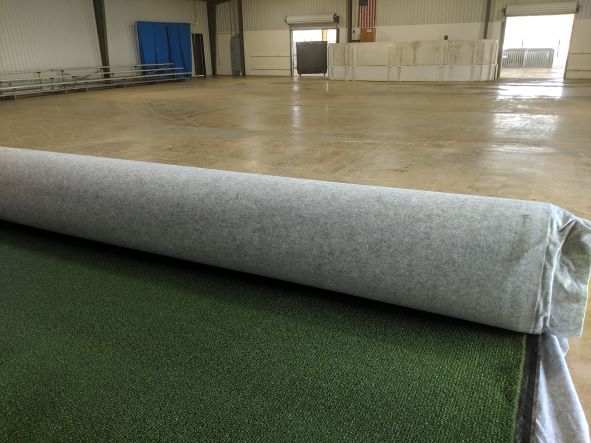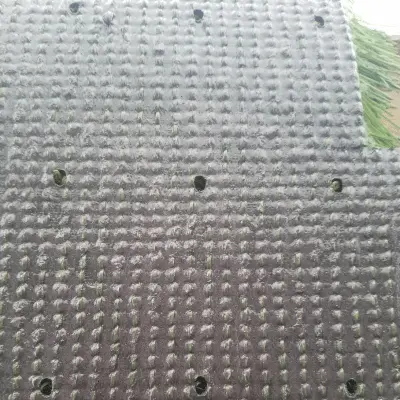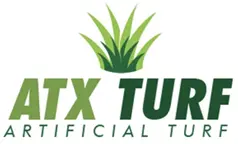Is There a Difference Between Indoor & Outdoor Artificial Turf?
Published July 9, 2023

The fibers themselves are either made of poly or nylon (like plastic) but both of these fibers can be used inside or outside.

Turf for Indoor Gym Floors
There is one distinguishing factor between an indoor and outdoor turf, and that’s whether the backing has drainage holes punched into it. “Punching” the turf is simply one of the final steps in the manufacturing process where the turf is run over a large cylinder with spikes on it every few inches. Many “padded” turfs are made for indoor sports and training facilities will often be manufactured without drainage holes, meaning, the manufacturer just skipped this last step of “punching.”
But it is also common to see padded turfs on a concrete slab for batting cages, so in that sense, even padded turfs are outdoor turf. A single batting cage often doesn’t need drainage as much as a yard or athletic field. Particularly, if the concrete slab is poured with a slight crown, the water will run off rather quickly since it is only 15’ wide.

Outdoor Turf Backing – Drainage Holes
Residential, Landscape and Sports Field Turfs will all have drainage holes, or the backing itself will be permeable. Instead of seeing actual holes every 4 inches or so, the backing is simply made of a very fine mesh, designed to allow the appropriate number of gallons per minute.
So is there a difference between Outdoor and Indoor Turf? Technically, yes, but turf is not manufactured in a way that it can ONLY be used Inside or Out.

I’m looking at the padded turf for my garage. Can it be vacuumed?
Hi Danny, Yes it can be vacuumed. The pile height is short enough.
Thanks!
The ATXTurf Team
I want to lay artificial turf for soccer on the concrete and the area 56 square meters
Which turfs do you recommend
can the turf you sell be uses for fitness areas that use sled training?
Hi Michael, Yes it can.
Thank You,
ATXTurf
We have outside dog runs for our kennel and the surface is currently pea gravel. Can we put outside turf over the pea gravel?
Hi Walter, Yes that should be fine for dog runs. Typically, “pea” gravel tends to be rounded as opposed to other gravel and doesn’t compact as well for the turf to lay firm and flat, so we would really have to see a picture of the gravel
Hello,
I am looking for turf for my indoor golf facility in Corpus Christi, Texas. Is there a difference between the batting cage turf, sports turf, and putting green turf?
Hi Mario, Yes there is. The putting green turf is a unidirectional “flat” turf while the batting cage turf and sports turf have a higher pile height, or taller blade.
Thank You,
ATXTurf Team
I have a pond that I would like to put turf on the house side of the pond. It is about 400 feet long and 25 feet wide with a slow slope with a lot of drainage into the pond. Would this be possible to do?
Hi Bruce, Yes that is doable. Turf comes in 15′ wide rolls so you would need two rows. While turf is often made in 200′ long rolls, we typically sell it up to 100′ simply because its difficult for many people to handle rolls larger than that without the proper equipment. An ATXTurf rep will reach out to you.
Looking for turf for a putting green on outside cement patio. Also want to be able to chip onto it – does the turf need padding under it so the chip won’t bounce too much.